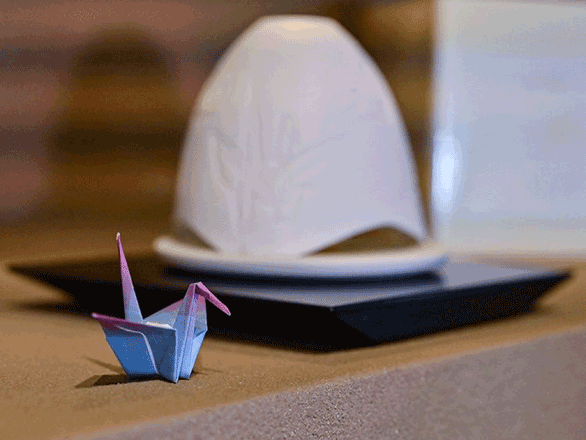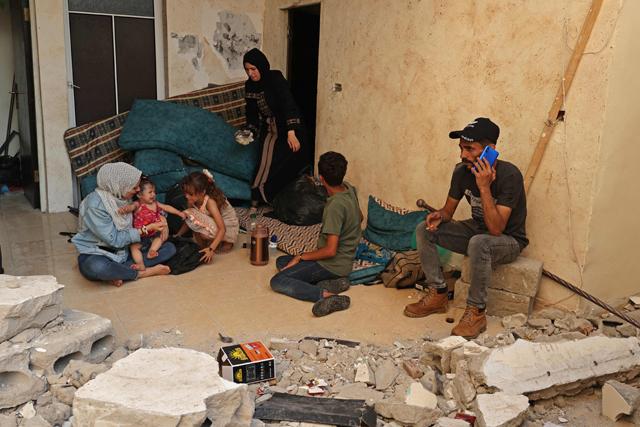You are here
Hiroshima bombing survivor looks back on fateful day
By Dana Al Emam - Nov 05,2016 - Last updated at Nov 06,2016

A photo on display at the Hiroshima Peace Memorial Museum (Photo by Dana Al Emam)
HIROSHIMA, Japan — The call for world peace is not without rhyme or reason for Katsuko Kuwanoto, a survivor of the 1945 Hiroshima atomic bombing.
The 77-year-old A-bomb survivor was not physically hurt by the bomb, but she witnessed its impact on people in her community, including her mother, as well as the devastation around the city.
When the bomb dropped on August 6, 1945, Kuwanoto, a first grader then, was at a school, some 3.5km away from the hypocentre.
Due to previous military air strikes, Kuwanoto and her elder sister had to move to a school far away from the city centre, where the majority of strikes hit. They stayed at their aunt’s house over the weekdays and visited home on the weekends.
Their mother stayed alone at their house in the city centre, and their father was fighting in the war.
“My classmates and I were playing in the schoolyard when we heard the big explosion, so we ran inside… the window glass shattered, and one of the girls playing beside the window was injured. Blood was coming out of her body like a fountain,” Kuwanoto said at a recent meeting with journalists.
The teacher held the girl in her arms and was running around in the yard not knowing what to do, she recalled, adding that all children were following their teacher.
This was Kuwanoto’s first encounter with the bombing, but not the last.
Her aunt came to school to take her home, but they all were very concerned about Kuwanoto’s mother.
“My brother decided to go to the city centre to check on my mother, but he was unable to proceed for more than 500 metres, as the entire city was on fire,” she said with tears in her eyes.
The first grader then saw the dead bodies covering the surface of the Ota River and on the riverside. The uncovered bodies were reeking in the summer heat, she said.
“At this point, we stopped looking for my mother.”
It turned out that her mother was having breakfast at home when the bomb hit, and she was unable to free herself from underneath the collapsed roof until her neighbour came to help.
“Only my mother, the neighbour who saved her and another neighbour they saw [covered] in blood were able to survive,” Kuwanoto’s said, adding that the three survivors called the names of the other residents of the area, but nobody answered.
It took a week for the fires to die down, and only then the mother was able to cross a mountain to reach the aunt’s house.
“I was shocked by her skin colour when I first saw her. She was extremely white without physical injuries,” said the survivor.
“At the time nobody in Hiroshima knew that it was a nuclear bomb… they called it pikadon, which means a flashing explosion.”
Slowly, Kuwanoto mother started feeling constant fatigue, falling down and bleeding frequently.
She was diagnosed with breast cancer that shortly spread to her lungs, neck and brain. She went into a coma and died.
The other bomb survivors went through the same symptoms.
 |
| Atomic bombing survivor Katsuko Kuwanoto points to a map of Hiroshima during a recent meeting with journalists in the Japanese city (Photo by Dana Al Emam) |
The saddest part of the story, according to Kuwanoto, was that the majority of the victims were high school students who were working at shops in the city centre to replace the adults who had gone to war.
“Sirens did not go off when the military aircraft carrying the A-bomb approached, so the students did not rush to shelters,” she said, noting that sirens generally alarmed people when military aircraft approached.
Another shock was when Kuwanoto returned to school after conditions calmed down.
The school was damaged, so classes were very crowded, and many students had been orphaned.
Stories of her classmates and the affected community started to slowly unpack, leaving her with a lifelong wound.
“I refused to share stories or talk about the bombing over the past 20 years, but as many A-bomb survivors have passed away and many of those alive were willing to speak, I felt I had a message to deliver to younger generations through storytelling,” she said.
However, delivering two talks daily to school students has not made it easier for Kuwanoto to accept the past, she said, adding that she sometimes loses her appetite.
“I still feel stuck in the past.”
US President Barack Obama’s visit to Hiroshima in May after the Group of Seven summit did not mean much to Kuwanoto, who saw the visit as just another stop on the itinerary of the American leader.
“Just because the Japanese did not ask for compensations at the time of the bombing does not mean that America should not compensate them,” she said.
All countries and world powers must immediately stop the arms race, stressed Kuwanoto, calling on world leaders to lend an ear to the large number of peaceful protests against nuclear bombs at the Hiroshima Peace Memorial all year round.
The atomic bombings of the cities of Hiroshima and Nagasaki killed around 80,000 Japanese people in a matter of hours, a figure that increased to over 140,000 by the end of 1945. The overall number of victims reached 250,000 over the following years.
Related Articles
MIYAJIMA, Japan — At a hillside temple, a monk in saffron robes blows a refrain on a conch and begins chanting prayers as thousands of origa
GAZA CITY, Palestinian Territories — Palestinian mother Rasha Qadoom clutches tight the tiny pink rucksack belonging to her five-year-
TOKYO — Japan on Thursday marked 75 years since the world's first atomic bomb attack, with the coronavirus pandemic forcing a scaling back o

















